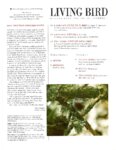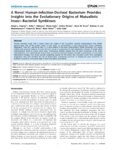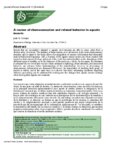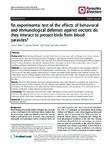|
|
Creator | Title | Description | Subject | Date |
| 1 |
 |
Seger, Jon | 1998 Sewall Wright Award: William Donald Hamilton | The Sewall Wright Award was established in 1991 to honor active investigators who have contributed in especially significant ways to the conceptual unification of the biological sciences. This year's recipient is William D. Hamilton of Oxford University. Beginning in the 1960s with his papers on the... | Evolution; Biological; Research | 1999 |
| 2 |
 |
Olivera, Baldomero M. | ?O-Conotoxins inhibit NaV channels by interfering with their voltage sensors in domain-2 | The ?O-conotoxins MrVIA and MrVIB are 31-residue peptides from Conus marmoreus, belonging to the O-superfamily of conotoxins with three disulfide bridges. They have attracted attention because they are inhibitors of tetrodotoxin-insensitive voltage-gated sodium channels (NaV1.8) and could therefore ... | | 2007 |
| 3 |
 |
Dearing, Maria-Denise | [Dearing_Database_Pilot] | [Database deposited March 08, 2013, as part of a pilot project, eResearch Committee, University of Utah.] [This description should include information that explains the dataset in detail in a manner that would be useful to potential reuse. The contact information for the primary investigator should ... | [Creator keywords here.] | 2013-03-08 |
| 4 |
 |
Sekercioglu, Cagan | A birders quide to Turkey | As I write, it is early December and the woods outside my window lay dusted with snow like a holiday card by Currier and Ives. A minute ago, I looked up and caught a glimpse of an adult Cooper's Hawk dashing swiftly through the trees. It swooped up, landed on a branch, then briefly shook its tail an... | | 2006-01-01 |
| 5 |
 |
Dale, Colin | A novel human-infection-derived bacterium provides insights into the evolutionary origins of mutualistic insect-bacterial symbioses | Despite extensive study, little is known about the origins of the mutualistic bacterial endosymbionts that inhabit approximately 10% of the world's insects. In this study, we characterized a novel opportunistic human pathogen, designated ‘‘strain HS,'' and found that it is a close relative of th... | | 2012-01-01 |
| 6 |
 |
Crespo, Jose Guillermo | A review of chemosensation and related behavior in aquatic insects | Insects that are secondarily adapted to aquatic environments are able to sense odors from a diverse array of sources. The antenna of these insects, as in all insects, is the main chemosensory structure and its input to the brain allows for integration of sensory information that ultimately ends in b... | | 2011-09-13 |
| 7 |
 |
Adler, Frederick R. | A time since recovery model with varying rates of loss of immunity | For many infectious diseases, immunity wanes over time. The majority of SIRS models assume that this loss of immunity takes place at a constant rate. We study temporary immunity within a SIRS model structure if the rate of loss of immunity can depend on the time since recovery from disease.We determ... | | 2012-01-01 |
| 8 |
 |
Olivera, Baldomero M.; McIntosh, J. Michael; Hillyard, David R. | A-superfamily of conotoxins: structural and functional divergence | The generation of functional novelty in proteins encoded by a gene superfamily is seldom well documented. In this report, we define the A-conotoxin superfamily, which is widely expressed in venoms of the predatory cone snails (Conus), and show how gene products that diverge considerably in stru... | Conotoxins; A-superfamily conotoxin | 2004-02-03 |
| 9 |
 |
| AAMC Award for Distinguished Research presentation for 1998 | This is a 3 minutes, 51 seconds video of the presentation of the American Association of Medical Colleges' Award for Distinguished Research to Mario Capecchi and Oliver Smithies for their independent work as pioneers in gene targeting. | Transgenic mice; Gene targeting; Genetic engineering; Mutagenesis; Capecchi, Mario R.; Science - Awards - United States; Smithies, Oliver; Awards presentations | 1998 |
| 10 |
 |
Ehleringer, James R. ; Cerling, Thure E. | Aberrant water homeostasis detected by stable isotope analysis | While isotopes are frequently used as tracers in investigations of disease physiology (i.e., 14C labeled glucose), few studies have examined the impact that disease, and disease-related alterations in metabolism, may have on stable isotope ratios at natural abundance levels. The isotopic composition... | | 2010-07-21 |
| 11 |
 |
Capecchi, Mario R. | Absence of radius and ulna in mice lacking hoxa-11 and hoxd-11. | Mice with targeted disruptions in Hox genes have been generated to evaluate the role of the Hox complex in determining the mammalian body plan. This complex of 38 genes encodes transcription factors that specify regional information along the embryonic axes. Early in vertebrate evolution an ancestra... | Alleles; Animals; Bone and Bones; Carpal Bones | 2003-09-02 |
| 12 |
 |
Beckerle, Mary C. | Activation-dependent redistribution of the adhesion plaque protein, talin, in intact human platelets | Talin is a high molecular weight protein localized at adhesion plaques in fibroblasts. It binds vinculin and integrin and appears to participate in generating a transmembrane connection between the extracellular matrix and the cytoskeleton. | Talin | 1989 |
| 13 |
 |
Shapiro, Michael D. | Adaptive evolution of pelvic reduction in sticklebacks by recurrent deletion of a Pitx1 enhancer | The molecular mechanisms underlying major phenotypic changes that have evolved repeatedly in nature are generally unknown. Pelvic loss in different natural populations of threespine stickleback fish has occurred by regulatory mutations deleting a tissue-specific enhancer of the Pituitary homeobox t... | Adaptive evolution; Pelvic reduction; Pituitary homeobox transcription factor 1; Pitx1; Gasterosteus aculeatus | 2010-01-14 |
| 14 |
 |
Beckerle, Mary C. | Adhesion plaque protein, talin, is phosphorylated in vivo in chicken embryo fibroblasts exposed to the tumor-promoting phorbol ester | Talin is a high molecular weight phosphoprotein that is localized at adhesion plaques. We have found that talin phosphorylation increases 3.0-fold upon exposure of chicken embryo fibroblasts to the tumor-promoting phorbol ester, phorbol 12-myristate 13-acetate. | Talin; Vinculin; Chicken embryo fibroblasts | 1990 |
| 15 |
 |
Adler, Frederick R. | Aggregation and stability in parasite-host models | This paper generalizes the two-dimensional approximation of models of macroparasites on homogeneous populations developed by Anderson & May (1978), focusing on how the dispersion (the variance to mean ratio) of the equilibrium distribution of parasites on hosts is related to the stability of the equ... | Aggregation; Stability; Host-parasite models | 1992-04 |
| 16 |
 |
| Albert Lasker Awards Ceremony, 2001 | This is the 1 hour, 45 minutes, and 41 seconds video of the Lasker Awards Ceremony and Banquet held in September, 2001. The Albert Lasker Award for Basic Medical Research was given to Mario R. Capecchi, Oliver Smithies, and Martin Evans for their work in genetic research. Martin Evans discovered h... | Capecchi, Mario R.; Gene targeting; Embryonic stem cells; Transgenic mice; Genetic engineering; Science - Awards - United States; Smithies, Oliver; Evans, Martin J.; Awards presentations | 2001 |
| 17 |
 |
Coley, Phyllis D.; Lokvam, John; Kursar, Thomas A. | Allelochemic function for a primary metabolite: the case of L-tyrosine hyper-production in Inga umbellifera (Fabaceae) | Young leaves of tropical forest trees experience far higher herbivory pressure than mature leaves of the same species. Selection on young leaves has led to diverse forms of defense chemical expression. Though most allelochemicals are secondary metabolites, allelochemic function for a primary metabol... | 5-amino-4-hydroxy-pentanoic acid; Panama; Barro Colorado Island; Fabaceae; Inga umbellifera; Primary metabolite; Heliothis virescens | 2006 |
| 18 |
 |
Beckerle, Mary C. | ALP-enigma protein ALP-1 functions in actin filament organization to promote muscle structural integrity in Caenorhabditis elegans | Mutations that affect the Z-disk-associated ALP-Enigma proteins have been linked to human muscular and cardiac diseases. Despite their clear physiological significance for human health, the mechanism of action of ALP-Enigma proteins is largely unknown. In Caenorhabditis elegans, the ALP-Enigma prot... | Actin; Caenorhabditis elegans; Contractility; alp-1 mutants; Z-disks; Kettin | 2009 |
| 19 |
 |
Capecchi, Mario R. | Altered enzymes in drug-resistant variants of mammalian tissue culture cells. | Two selective procedures are compared in an effort to isolate variants of mouse L cells containing structural gene mutations. Among the resulting variant cloned cell lines are found two types of alterations in theenzyme hypoxanthine phosphoribosyl transferase (EC 2.4.2.8.) (1): enzyme with altered ... | Drug Resistance; Azaguanine; Clone Cells; Hypoxanthines | 1973-11 |
| 20 |
 |
Adler, Frederick R. | Alternating host cell tropism shapes the persistence, evolution and coexistence of Epstein-Barr virus infections in human | Epstein-Barr virus (EBV) infects and can persist in a majority of people worldwide. Within an infected host, EBV targets two major cell types, B cells and epithelial cells, and viruses emerging from one cell type preferentially infect the other. We use mathematical models to understand why EBV infec... | | 2011 |
| 21 |
 |
Adler, Frederick R. | Alternating host cell tropism shapes the persistence, evolution and coexistence of Epstein-Barr virus infections in human | Epstein-Barr virus (EBV) infects and can persist in a majority of people worldwide. Within an infected host, EBV targets two major cell types, B cells and epithelial cells, and viruses emerging from one cell type preferentially infect the other. We use mathematical models to understand why EBV infec... | | 2010 |
| 22 |
 |
Olivera, Baldomero M. | Alternative splicing in the pore-forming region of shaker potassium channels | We have cloned cDNAs for the shaker potassium channel gene from the spiny lobster Panulirus interruptus. As previously found in Drosophila, there is alternative splicing at the 59 and 39 ends of the coding region. However, in Panulirus shaker, alternative splicing also occurs within the pore-forming... | Panulirus interruptus; Conotoxins; Shaker; Stomatogastric ganglion; Pore-forming region; Alternative splicing | 1997 |
| 23 |
 |
Coffin, Cheryl M.; Capecchi, Mario R. | Alveolar rhabdomyosarcomas in conditional Pax3:Fkhr mice: cooperativity of Ink4a/ARF and Trp53 loss of function. | Alveolar rhabdomyosarcoma is an aggressive childhood muscle cancer for which outcomes are poor when the disease is advanced. Although well-developed mouse models exist for embryonal and pleomorphic rhabdomyosarcomas, neither a spontaneous nor a transgenic mouse model of alveolar rhabdomyosarcoma has... | Cell Differentiation; Forkhead Transcription Factors; Myogenic Regulatory Factors | 2004-11-01 |
| 24 |
 |
Olivera, Baldomero M. | Aminoglycoside effects on voltage-sensitive calcium channels and neurotoxicity | To the Editor: Since ototoxicity and neuromuscular toxicity of aminoglycoside antibiotics are reversed by calcium, 1,2 and presynaptic events appear to be involved in aminoglycoside-induced neuromuscular blockade, 3,4 we suspected a role for voltage-sensitive calcium channels in aminoglycoside neuro... | Conotoxins | 1987 |
| 25 |
 |
Clayton, Dale H. | An experimental test of the effects of behavioral and immunological defenses against vectors: do they interact to protect birds from blood parasites? | Background: Blood-feeding arthropods can harm their hosts in many ways, such as through direct tissue damage and anemia, but also by distracting hosts from foraging or watching for predators. Blood-borne pathogens transmitted by arthropods can further harm the host. Thus, effective behavioral and im... | | 2014-01-01 |

























